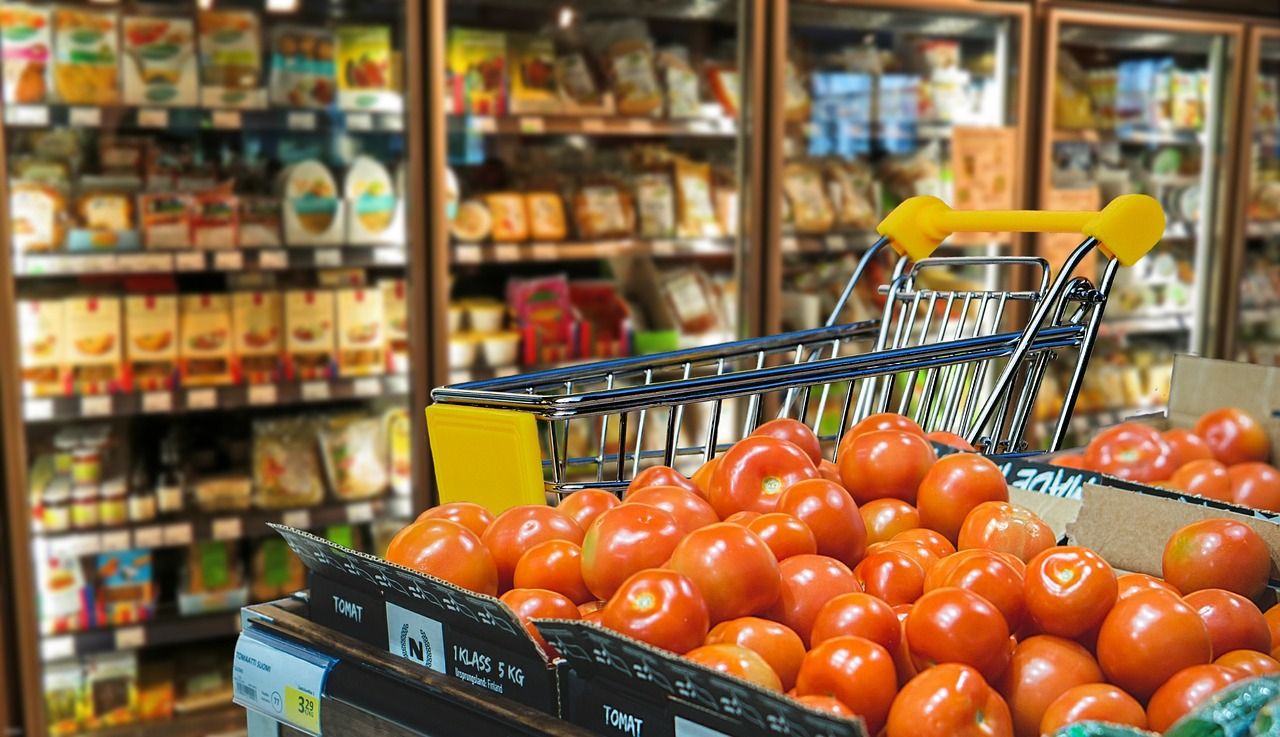Smart Ways to Save Money on Grocery Shopping
Studies show that implementing smart shopping strategies can save the average household hundreds of dollars annually on groceries.

Key Takeaways
- Smart Shopping Strategies: Make the most of your grocery shopping by buying in-season produce, shopping during sales, and planning meals around what's available.
- Planning Ahead: Save money by creating a budget-friendly grocery list based on meal plans to avoid unnecessary purchases.
- Couponing 101: Maximize your savings at the store by finding and effectively using coupons, including digital coupons and coupon apps.
- Comparing Prices: Use price comparison apps and strategies to find the best local deals and cut your grocery expenses.
- DIY vs. Store-Bought: Learn the benefits of homemade meals - they are often cheaper and healthier than pre-made options.
- Bulk Buying Benefits: Understand which items are beneficial to buy in bulk, such as non-perishables and staple items, to save money in the long run.
- Loyalty Programs: Use supermarket loyalty programs for extra discounts and rewards.
- Avoid Impulse Buys: Stick to your grocery list and budget to avoid impulsive and unnecessary purchases.
- Frugal Strategies: Adopt strategies like reducing meat consumption, buying generic brands, and growing your own produce to slash your grocery bill.
- Affordable Shopping Hacks: Discover hacks like using cash-back apps, checking unit prices, and shopping at discount grocers for smart grocery budgeting.
Introduction
In today's fast-paced world, managing a household budget effectively is crucial, and a significant part of that budget is often dedicated to grocery shopping. However, with smart planning and strategic shopping, it's possible to significantly cut your grocery expenses and make your budget stretch further. This article will provide you with a comprehensive guide to budget-friendly grocery shopping, packed with practical tips and strategies.

Whether you're wondering about ways to save on grocery shopping, looking for grocery saving tips, or interested in discovering budget-friendly grocery shopping techniques, we've got you covered. We'll delve into ingenious ways to cut grocery expenses, frugal grocery shopping strategies, and affordable grocery shopping hacks that will help you slash your grocery bill without compromising on the quality or quantity of your food.
This article also includes smart grocery budgeting techniques and advice on how to make the most of store loyalty programs for extra grocery discounts. From planning ahead with a budget-friendly grocery list to avoiding impulse buys, these strategies will guide you towards making informed and cost-effective choices.
So, whether you're a busy parent, a student living away from home for the first time, or anyone looking to make smarter financial decisions, read on. It's time to take control of your grocery shopping and start saving today.
Smart Shopping Strategies for Grocery Savings
Grocery shopping doesn't have to be a budget-busting experience. With some smart shopping strategies, you can make significant savings and reduce your overall household expenses.
One effective strategy is to buy produce that's in-season. Seasonal fruits and vegetables are not only fresher and tastier but are also generally cheaper than out-of-season produce that's imported from other regions or countries.
Sales are another excellent opportunity to save. Most grocery stores have weekly sales on different items, providing a chance to stock up on essentials at discounted prices. Be sure to check weekly flyers and sign up for store newsletters to stay informed about the latest deals.
Meal planning is another crucial component of smart grocery shopping. By planning meals around what's already in your pantry or what's on sale, you can avoid wasting food and money. For example, if you have a lot of pasta at home, consider planning a few pasta-based meals for the week. Or if chicken is on sale, plan meals like chicken stir-fry or chicken casserole.
Grocery shopping doesn't have to be a drain on your wallet. With smart shopping strategies, you can make significant savings. Here are a few key strategies:
- Buy In-Season Produce: Fruits and vegetables that are in-season are often more affordable and at peak freshness. For example, strawberries are cheaper in the summer, while oranges are less expensive in the winter. Buying seasonally can save you up to 30-50% on produce costs.
- Shop Sales: Most grocery stores run weekly sales. Make it a habit to check store flyers or apps for discounts and plan your meals around these sales. On average, this could shave off 20-30% from your grocery bill.
- Plan Meals Around What's On Hand: Before you shop, take inventory of what you already have. Plan meals based on these items to avoid unnecessary purchases. This simple strategy can save you hundreds of dollars annually.
- Shop Late or Early: Some stores offer discounts on bakery, meat, and dairy items late in the evening or early in the morning. You could save up to 50% off items approaching their sell-by date.
By implementing these strategies, you can significantly reduce your grocery expenses and make budget-friendly choices.
Remember, every dollar saved on grocery shopping is a dollar that can be used elsewhere in your budget. So, equip yourself with these strategies and start saving today!

Planning Ahead: Creating a Budget-Friendly Grocery List
Planning ahead is a cornerstone of budget-friendly grocery shopping. By creating a detailed grocery list based on planned meals, you can ensure that you buy only what you need, thereby avoiding unnecessary purchases and waste.
Start by mapping out your meals for the week, taking into account your schedule and the preferences of everyone in the household. From these meal plans, create a list of ingredients you'll need. Be sure to check your pantry and refrigerator first to avoid buying items you already have.
Armed with your list, you can enter the grocery store with a clear plan. It's essential to stick to your list as closely as possible to keep your spending on track. Impulse buys – those tempting items that catch your eye as you stroll the aisles – can quickly add up and blow your budget.
Avoid shopping when you're hungry, as this can lead to unplanned purchases. Instead, try to shop after a meal. Additionally, consider using a grocery list app on your smartphone. These can help you organize your list, keep track of what you've already bought, and even compare prices between different stores. With careful planning and a little discipline, a well-thought-out grocery list can become a powerful tool in your budgeting arsenal.
Creating a budget-friendly grocery list is a fundamental step in saving money on groceries. Here's how you can effectively utilize this strategy:
- Meal Planning: Planning your meals for the week can help you avoid buying unnecessary items. Aim to create a balance of meals that include a variety of food groups and make use of what you already have at home. This can reduce your grocery expenses by up to 20%.
- Creating a List: Once your meals are planned, create a detailed grocery list. Having a list can help you focus on what you need and resist the temptation of impulse buys. By sticking to a list, you can potentially save 10-15% on your grocery bill.
- Checking Pantry: Before you shop, always check your pantry, fridge, and freezer. This can prevent you from buying items you already have, which can waste an estimated 25% of your grocery budget.
- Order of Shopping: When shopping, start with non-perishable goods, then frozen items, and finally perishable items like dairy and vegetables. This order ensures your cold items spend less time out of the fridge, reducing the risk of spoilage and waste.
By planning ahead and sticking to a budget-friendly grocery list, you can significantly decrease unnecessary purchases, reduce waste, and make your grocery shopping more efficient.
Detailed Budget Planning: A Step-by-Step Guide
Creating and sticking to a grocery budget is crucial for managing household finances effectively. This detailed step-by-step guide will help you set up a grocery budget that fits your needs and saves you money:
Step 1: Track Current Spending
Before you can create a budget, you need to know where your money is going. For one month, keep all your grocery receipts or track your spending using a budgeting app. This will give you a clear picture of your current spending habits.
- Tip: Make a note of everything, from small snacks to big meals. This comprehensive data will be the foundation for your budget.
Step 2: Categorize Expenses
Once you have your spending data, categorize each item you've purchased. Common categories include:
- Meats and Proteins: Chicken, beef, fish, eggs, legumes.
- Vegetables and Fruits: Fresh, frozen, canned.
- Dairy and Alternatives: Milk, cheese, yogurt, plant-based alternatives.
- Grains and Staples: Bread, rice, pasta, oils.
- Snacks and Sweets: Chips, cookies, candy.
- Tip: Use a spreadsheet to organize these categories. This makes it easier to see which areas of your grocery spending are highest.
Step 3: Set Spending Goals
Analyze your categorized spending to identify areas for potential savings. Set realistic budget goals for each category, focusing on reducing non-essential spending first.
- Prioritization: Ensure your budget prioritizes essential nutrients and staples that sustain your household.
- Flexibility: Allow for some flexibility in categories like fruits and vegetables, where seasonal availability might affect prices.
Step 4: Plan Meals
Meal planning is a powerful tool for budgeting. Plan your meals for the week or month based on:
- Seasonal Availability: Incorporate ingredients that are in-season to reduce costs.
- Current Inventory: Use what you already have in your pantry to minimize purchases.
- Sales and Discounts: Take advantage of weekly sales at your local grocery stores.
- Tip: Create a meal plan calendar. This visual aid can help you stick to your planned meals and shopping list, reducing the likelihood of impulse buys.
Step 5: Use Tools and Apps
To keep your grocery budget on track, use tools and apps that can help you monitor your spending and adjust as needed.
- Budgeting Apps: Apps like Mint or YNAB (You Need a Budget) can connect to your bank accounts to help you track grocery spending in real time.
- Spreadsheets: Google Sheets or Microsoft Excel can be used to track expenses manually but offer more customization for budget categories and long-term tracking.
- Tip: Set up alerts or reminders to review your grocery budget weekly. This keeps you mindful of your spending and lets you adjust quickly if you're going off track.
Regular Review and Adjustment
Finally, review your budget and spending habits regularly. As your dietary needs or food prices change, your budget should evolve too. Adjust your spending goals every few months to accommodate changes like dietary preferences, seasonal shifts in produce pricing, or financial changes in your household.
By following these steps, you can create a detailed and effective grocery budget that not only helps you save money but also supports healthy and sustainable eating habits for your entire family.

Couponing 101: Maximizing Savings at the Store
In the quest for budget-friendly grocery shopping, coupons can be your secret weapon for maximizing savings. With a bit of time and effort, you can save substantially on your grocery bills.
Traditionally, coupons have been available in newspapers and magazines, but with the rise of digital technology, a plethora of digital coupons and coupon apps are now at your fingertips. These resources often offer greater convenience and a wider range of deals than traditional paper coupons.
To start, sign up for your preferred store's loyalty program. These programs often provide digital coupons that you can load directly onto your loyalty card for instant savings at checkout. Additionally, many grocery chains have their own apps where they post exclusive deals and digital coupons.
Moreover, there are numerous coupon apps available, such as Rakuten, Ibotta, and Honey, which aggregate deals from various stores, allowing you to compare and choose the best ones.
Coupons are a valuable tool for saving money on groceries. Here's how you can maximize your savings:
- Finding Coupons: Look for coupons in newspapers, magazines, store flyers, and websites. Also, many grocery stores offer digital coupons on their apps. Using coupons can save you an average of 10-20% on your total grocery bill.
- Use Coupon Apps: Several apps like Ibotta, SavingStar and Coupons.com offer digital coupons and rebates. You can save an additional 5-15% by using these apps.
- Combine Coupons and Sales: For maximum savings, use your coupons when the items are on sale. This strategy, known as 'stacking', can sometimes even result in getting items for free.
- Organize Your Coupons: Keep your coupons organized by categories, expiration dates or stores. This will help you find them easily when needed and ensure you use them before they expire.
- Understand Store Policies: Each store has its own coupon policy. Understanding these policies can help you make the most of your coupons. Some stores may double the value of coupons, while others may allow you to use multiple coupons on a single item.
By effectively using coupons, you can significantly reduce your grocery bill and make budget-friendly grocery shopping a reality.
Remember, effective couponing is about using coupons for items you would buy anyway, not buying items just because you have a coupon. By keeping this strategy in mind, you can maximize your savings and make your grocery budget go even further.
Comparing Prices: Finding the Best Deals in Your Area
Price comparison is a smart shopping strategy that can help you find the best deals in your area, ensuring you get the most value for your money.
To start, use price comparison apps like Basket, ShopSavvy, or BuyVia. These apps allow you to compare prices on specific items from different stores in your local area. Simply enter the product you're looking for, and the app will show you where to find the best deal. Some apps even let you scan barcodes or QR codes in-store to see if the item is cheaper elsewhere.
Another strategy is to familiarize yourself with the typical prices of items you frequently buy. This way, you'll know a good deal when you see one. Additionally, consider the unit price (the cost per unit of measure, like per ounce or per item) to compare different brands and sizes effectively.
Also, don't forget to explore different types of stores, including discount stores, farmer's markets, and online retailers. Each can offer different deals and savings opportunities.
Price comparison is a crucial strategy for finding the best deals. Here's how to do it effectively:
- Use Price Comparison Apps: Apps like Basket Savings and ShopSavvy allow you to compare prices from different stores in your area. You can save up to 20-30% by choosing the store with the best deal.
- Check Store Brands: Store brands often offer the same quality as name brands at a lower price. Switching to store brands can save you an average of 25%.
- Bulk Buying: If you consume a product regularly, consider buying it in bulk. This can lead to significant savings, often up to 50%.
- Seasonal and Sale Items: Pay attention to seasonal items and sales. This could shave off an additional 10-20% from your grocery bill.
- Loyalty Programs: Many stores offer loyalty programs that give you access to exclusive deals. Joining these programs can lead to an additional 5-10% savings.
By comparing prices and finding the best local deals, you can significantly reduce your grocery expenses and make budget-friendly choices.
Remember, every penny saved adds up over time. By comparing prices and shopping strategically, you can stretch your grocery budget further and enjoy significant savings in the long run.
DIY vs. Store-Bought: Cost-Effective Meal Solutions
Choosing to make meals at home rather than purchasing pre-made versions can often be a more cost-effective solution. It also provides the added benefit of being healthier, as homemade meals are typically free of the preservatives and high sodium levels found in many store-bought options.
Preparing meals at home rather than buying pre-made options can save you money and improve your health. Here are some examples:
- Pasta Dishes: Homemade pasta dishes can be up to 50% cheaper than store-bought or restaurant versions. Plus, you can control the ingredients to make it healthier, like using whole wheat pasta and fresh vegetables.
- Salads: Pre-packaged salads can be overpriced. Making your own can save you around 30-40% and you can ensure the freshness of your ingredients.
- Soups: Store-bought soups often contain high levels of sodium. Homemade versions can cost up to 60% less, and you can control the salt content, making it a healthier choice.
- Smoothies: Buying a smoothie can cost around $5-$7 each. Making them at home can save you about 70%, and you can choose your own ingredients, avoiding added sugars.
- Coffee: Brewing your own coffee at home can save you up to 95% compared to buying it from a coffee shop. Plus, you can adjust the sweetness to your liking.
By preparing meals at home, you not only save money but also have control over what goes into your food, making it a healthier choice.
Moreover, homemade meals allow you to control portion sizes, reducing waste and ensuring that your family is eating balanced, nutritious meals. This approach can greatly reduce your grocery bill while boosting your health quotient. It's a win-win situation.

Bulk Buying Benefits: How to Save Money in the Long Run
Buying in bulk is a strategic approach to shopping that can save you substantial amounts of money in the long run, particularly when it comes to non-perishable and staple items.
Non-perishable items such as canned goods, rice, pasta, and dried beans are ideal for bulk purchasing. These items have a long shelf life and are typically cheaper per unit when bought in larger quantities. Similarly, household essentials like toilet paper, cleaning supplies, and laundry detergent are also cost-effective to buy in bulk.
Buying in bulk can be a key strategy for long-term savings on groceries. Here's how:
- Non-Perishables: Items such as canned goods, pasta, rice, and beans are ideal for bulk buying. They have a long shelf life and are often cheaper when bought in large quantities, saving you up to 20-30%.
- Staple Items: Regularly used items like cooking oil, spices, flour, and sugar can be bought in bulk for significant savings. This can save you an average of 15-25%.
- Frozen Foods: Bulk buying frozen fruits, vegetables, and meats can be more cost-effective than buying fresh, with potential savings of up to 50%.
- Household Items: Toilet paper, cleaning supplies, and other household essentials are often cheaper when bought in bulk, leading to a potential 10-20% savings.
- Healthier and Less Packaging: Bulk buying often means less packaging, which is better for the environment. Plus, bulk items are typically less processed, leading to healthier meal options.
By buying in bulk, you can save money in the long run, reduce packaging waste, and have a constant supply of essentials at home.
Bulk buying also goes hand in hand with meal planning. For instance, buying meat in bulk, portioning it out, and freezing it for future meals can be a real money-saver.
However, it's crucial to only buy items you know you'll use, as the cost savings can quickly disappear if items go unused and spoil.
Remember to compare unit prices to ensure you're getting the best deal. Sometimes, a larger package isn't always cheaper.
Lastly, consider shopping at warehouse clubs like Costco or Sam's Club, which specialize in bulk items and often offer significant savings. With careful planning and strategic shopping, buying in bulk can be a key tool in your money-saving arsenal.
Utilizing Loyalty Programs for Extra Grocery Discounts
Supermarket loyalty programs are an excellent tool for saving money on your grocery shopping. By signing up for these programs, you can earn discounts and rewards over time that significantly reduce your grocery bills.
These programs work by accumulating points each time you shop. The points can then be redeemed for discounts on future purchases. Some supermarkets even offer double or triple points on certain items or during specific shopping periods, allowing you to earn rewards faster.
In addition to immediate discounts at the checkout, loyalty programs often provide members with exclusive offers and promotions. These can range from discounts on specific product categories to buy-one-get-one-free deals.
Supermarket loyalty programs are a fantastic way to save money on groceries. Here's how you can maximize these savings:
- Sign Up for Loyalty Programs: Most supermarkets offer loyalty programs that provide members with exclusive discounts. Signing up for these programs can save you an average of 5-10% on your grocery bill.
- Earn Points for Purchases: For every dollar spent, loyalty programs typically award points that can be redeemed for discounts on future purchases. This can amount to an additional 1-5% in savings.
- Special Discounts and Sales: Members often get early access to sales or exclusive member-only discounts. This can result in savings of up to 20% on certain items.
- Bonus Rewards on Certain Products: Some loyalty programs offer bonus points on certain products. Buying these products can accelerate your point accumulation and lead to bigger discounts.
- Digital Coupons: Many loyalty programs offer digital coupons that can be loaded directly onto your loyalty card. These can add up to significant savings over time.
By utilizing loyalty programs, not only can you save money, but you can also enjoy a more personalized shopping experience.
Some programs also offer personalized deals based on your shopping history. This means you could receive discounts on the items you buy most often, further enhancing your savings.
Lastly, many loyalty programs offer digital coupons that can be loaded directly onto your loyalty card and automatically applied at checkout. This eliminates the need to clip paper coupons and ensures you never miss out on a deal.
By fully utilizing these loyalty programs, you can make your money go further and save significantly on your grocery shopping.
Tips for Avoiding Impulse Buys and Sticking to Your Budget
Impulse buying can quickly derail your budget. Here are some practical tips to avoid it and stick to your spending plan. Impulse purchases can derail your budget quickly. Here are some practical tips to avoid them:
1. Shop on a Full Stomach: Firstly, never shop on an empty stomach. Hunger can make everything look appealing, leading to unnecessary purchases. Eating a meal before you shop can help curb these impulses. When you're hungry, everything looks tempting, leading to unnecessary purchases. Studies show you can save up to 15-20% on your grocery bill by shopping post-meal.
2. Use a Shopping List: Secondly, always bring a shopping list and stick to it. A list not only ensures you won't forget essential items, but also serves as a reminder of what you don't need. It's a physical manifestation of your shopping plan, which can help deter impulse buys. Make a list and stick to it. This can help you avoid buying items you don't need and can cut your grocery bill by up to 20%.
3. Set a Firm Budget: Setting a firm budget is another crucial strategy. Knowing exactly how much you can spend can help you make more conscious decisions about what to put in your cart. Determine how much you can spend on groceries each week or month. Stick to this budget strictly. This can save you up to 30% on your total grocery expenses.
- Avoid Sales Traps: Just because an item is on sale, doesn't mean you need it. Avoid buying items on sale unless they're already on your list.
- Limit Store Visits: The less frequently you visit the store, the less you're likely to make impulse purchases. Try to do a big shop once a week instead of multiple smaller trips.
By implementing these strategies, you can avoid impulse buys, stick to your budget, and make significant savings on your grocery bill.
Another effective tip is to shop alone, if possible. Shopping with others, especially children, can lead to added items in your cart.
Lastly, consider using cash or a debit card for shopping. The physical act of handing over cash or seeing your bank balance decrease can make the cost of impulse buying more tangible and thus easier to resist.

Frugal Grocery Shopping Strategies
Grocery shopping on a budget doesn't mean you have to compromise on quality. Here are some effective strategies:
- Reduce Meat Consumption: Consider incorporating more plant-based meals into your diet. Meat can be expensive, and reducing its consumption could save up to 20% on your grocery bill.
- Buy Generic Brands: Generic brands often offer the same quality as name brands but at a lower price. Opting for generic brands can lead to an average savings of 25%.
- Grow Your Own Produce: Starting a small vegetable garden can be a cost-effective way to get fresh produce. It's a long-term investment with benefits, potentially saving you 30% or more on produce.
- Shop Seasonally: Seasonal fruits and vegetables are often cheaper. You could save around 10-15% by sticking to seasonal produce.
- Plan Your Meals: Meal planning helps avoid wasting food and money. By planning your meals, you could save around 20% on your grocery bill.
By implementing these strategies, you can enjoy a variety of nutritious foods while sticking to your budget.
Affordable Grocery Shopping Hacks
- Use Cash-Back Apps: Apps like Ibotta and Rakuten offer cash-back on grocery purchases. You could save up to 10% on your total bill using these apps.
- Check Unit Prices: The unit price (price per ounce or gram) is often cheaper for larger sizes. By checking the unit price, you could save up to 20% on your purchase.
- Shop at Discount Grocers: Discount grocers like Aldi and Lidl offer quality products at lower prices. Shopping at these stores could reduce your grocery bill by 30%.
- Buy in Season: Fruits and vegetables are cheaper and fresher when bought in season. You could save up to 50% on produce by purchasing in-season items.
- Make Use of Sales and Coupons: Keep an eye out for sales and coupons, which can greatly reduce your grocery bill. The average household saves about 6% using coupons.
- Buy Store Brands: Store brands are often just as good as name brands but up to 25% cheaper.
- Plan Your Meals: Meal planning reduces waste and ensures you only buy what you need. This can result in savings of up to 20%.
By utilizing these hacks, you can make your grocery shopping more affordable without sacrificing quality.
Local Shopping Benefits: The Advantages of Buying from Farmers' Markets and Local Producers
Shopping at local farmers' markets or buying directly from local producers offers numerous benefits that extend beyond just acquiring your groceries. Here's a detailed look at why choosing local can be a great addition to your shopping routine:
1. Enhanced Freshness and Quality
Products at local farmers' markets are often harvested at their peak of ripeness, providing superior flavor and nutrition. Unlike produce that travels thousands of miles from farm to supermarket, local produce is sold shortly after harvest. This quick transition from farm to table not only maintains the nutritional quality but also ensures you enjoy the freshest food possible.
2. Lower Costs
Shopping locally can often save you money. Farmers and local producers typically have lower transportation and marketing costs, and these savings can be passed on to the consumer. Additionally, because you’re buying directly from the source, there's no middleman markup, which often leads to better prices compared to grocery stores.
3. Supporting the Local Economy
When you shop from local farmers and producers, your money stays within the community, helping to boost the local economy. This support helps local businesses thrive and creates jobs within the community. Furthermore, thriving local businesses can lead to increased property values and a robust local economy that benefits all residents.
4. Reducing Environmental Impact
Local shopping can significantly reduce your carbon footprint. Food in the U.S. travels, on average, 1,500 miles to get to your plate. Buying locally reduces the need for long-distance food transportation, thus cutting back on fuel consumption and air pollution. Furthermore, local farmers are more likely to employ sustainable practices that minimize environmental impact compared to larger agricultural operations.
5. Building Community Connections
Shopping locally provides an opportunity to engage with growers and producers directly, allowing for a better understanding of where and how your food is produced. These interactions can lead to a greater sense of community and trust between consumers and suppliers. It also offers a chance to learn about local agriculture and seasonal produce, fostering a deeper connection with your food.
6. Promoting Genetic Diversity
Local farmers often grow a wide variety of crops to provide a long harvest season, an array of colors, and the best flavors. Unlike larger commercial farms focusing on mono-cropping, local markets feature unique, diverse produce that is less commonly found in typical grocery stores. This diversity helps protect biodiversity and preserves a wider agricultural heritage.
7. Healthier Options
Local markets often have more organic and pesticide-free produce compared to traditional grocery stores. Small local farms are more likely to use organic methods, meaning the food you consume is free from harmful chemicals and pesticides, promoting better health and wellness.
Incorporating local shopping into your routine is not only beneficial for your health and wallet but also for your community and the planet. Next time you need to stock up on groceries, consider visiting your local farmers' market or buying directly from local producers. You’ll enjoy fresher, tastier produce, support sustainable agriculture, boost your local economy, and contribute to a healthier environment.

Recipes Using Commonly Discounted Items or Bulk Purchases
Incorporating recipes that utilize commonly discounted items or ingredients bought in bulk can make your savings stretch further while providing nutritious and delicious meals. Here are a few simple recipes to get you started:
Bulk Rice and Beans Recipe
A staple dish in many cultures, rice and beans together form a complete protein, making this a nutritious and economical meal.
Ingredients:
- 1 cup rice
- 1 cup dried beans (soaked overnight)
- 1 large onion, chopped
- 2 cloves garlic, minced
- 1 teaspoon cumin
- 1 teaspoon paprika
- Salt and pepper to taste
Directions:
- Prepare the Beans: Drain the soaked beans. In a large pot, add beans and cover with water. Bring to a boil, then reduce to a simmer. Add half the chopped onion and the minced garlic. Cook until the beans are tender, about 1-2 hours.
- Cook the Rice: In a separate pot, cook the rice according to package instructions.
- Season: Once the beans are cooked, stir in cumin, paprika, salt, and pepper. Add the remaining onion for extra crunch and flavor.
- Combine and Serve: Mix the cooked rice and beans together. Adjust seasoning if needed and serve warm.
Seasonal Vegetable Stir-Fry
This flexible recipe allows you to use whatever vegetables are in season, ensuring you get the freshest and most cost-effective ingredients.
Ingredients:
- Assorted in-season vegetables (e.g., bell peppers, zucchini, carrots)
- 200 grams of tofu or chicken, cut into cubes
- 2 tablespoons soy sauce
- 1 tablespoon olive oil
- 1 teaspoon fresh ginger, minced
- Optional: sesame seeds or chopped nuts for garnish
Directions:
- Prep Ingredients: Wash and chop the vegetables into bite-sized pieces. If using chicken, make sure it’s diced into small cubes.
- Cook Protein: Heat olive oil in a large pan or wok over medium-high heat. Add ginger and stir for about 30 seconds. Add chicken or tofu and cook until browned and cooked through.
- Add Vegetables: Add the chopped vegetables to the pan. Stir-fry for 5-7 minutes until the vegetables are tender but still crisp.
- Season: Add soy sauce and toss everything together to coat evenly. Cook for an additional minute.
- Serve: Serve hot. Garnish with sesame seeds or chopped nuts if desired.
Pumpkin Soup (October Special)
Pumpkin is abundant and inexpensive in October, making this warm, comforting soup perfect for fall.
Ingredients:
- 1 medium pumpkin, peeled and cubed (about 4 cups)
- 1 large onion, chopped
- 2 cups vegetable broth
- 1/2 cup cream (optional for richness)
- Salt, pepper, and nutmeg to taste
- Olive oil
Directions:
- Cook Vegetables: In a large pot, heat a splash of olive oil over medium heat. Add the onion and cook until translucent. Add the cubed pumpkin and cook for about 10 minutes, stirring occasionally.
- Simmer: Add the vegetable broth and bring to a boil. Reduce the heat and simmer until the pumpkin is soft, about 20 minutes.
- Blend: Use an immersion blender to puree the soup until smooth. If using a regular blender, allow the mixture to cool slightly before blending in batches.
- Season and Finish: Return the blended soup to the pot. Stir in cream if using, and season with salt, pepper, and a pinch of nutmeg. Heat through.
- Serve: Serve warm with a dollop of cream or a sprinkle of nutmeg on top for extra flavor.
These recipes not only utilize budget-friendly ingredients but also transform them into hearty meals that can cater to any taste preferences, ensuring that your grocery shopping is both economical and delightful.
Conclusion
In conclusion, managing your budget while grocery shopping doesn't have to be a daunting task. Several practical strategies can help you avoid impulse purchases and save money. Remember to shop on a full stomach, stick to a list, set a firm budget, shop alone if possible, and consider using cash or a debit card.
Frugal grocery shopping strategies can help you make the most of your budget. Consider reducing meat consumption, buying generic brands, and even growing your own produce. Furthermore, affordable grocery shopping hacks like using cash-back apps, checking unit prices, and shopping at discount grocers can lead to significant savings.
These tips and strategies are not just about saving money. They're about making conscious decisions and being in control of your spending, which leads to better financial health. It's about being mindful of what you're buying and why.
Remember, every little change can make a big difference. So, why not start implementing these strategies today? Your wallet will thank you. And over time, you'll find that these small steps can lead to significant savings and better financial health. Let's get started on your journey to frugal and financially savvy grocery shopping!
